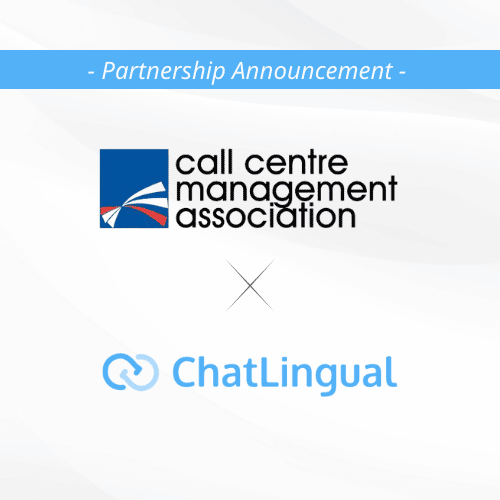In 2022, Speaking the Customer’s Language Is a Must for Any Enterprise
When brand managers draft plans for a more global reach and set their sights to enhance customer experiences, they must explore whether language barriers hinder their sales and support contact centers from attracting and retaining loyal customers.
One of the best ways to connect with and retain customers is to speak their native language. In a 2020 CSA Research study of online shoppers from 29 countries on four continents, nearly 80 percent of respondents said they prefer purchasing products with information provided in their native language. What’s more: 66 percent of the same pool of shoppers said they use automated translation to help guide them through the global marketplace, even if their confidence in their ability to read English was strong.
Even more astounding: 75 percent of these consumers indicated they would become repeat customers if a brand offers multilingual customer care. This preference is strongest among less confident English speakers but can ultimately be the deciding factor when these customers are given a choice between two similar products. This has only increased in the digital transformation accelerated by the COVID-19 pandemic.
Nearly 90 percent of non-English speaking consumers said they are more likely to purchase a product from brands with multilingual support systems and knowledge bases.
Yet one-fifth of contact centers do not measure the quality of their non-primary language contacts. Brands are turning their back on their customers and then ignoring the adverse effect the practice has on their reputation and customer satisfaction – even though 59 percent of English-as-a-second-language customers award brands that speak their primary language with higher Customer Service Satisfaction ratings.
How the Customer Experience Movement Changed What We Know About Language
Even organizations with a strictly domestic focus are experiencing increased demand for multilingual support from their non-primary language customers within the United States. In the 2020 U.S. Census, 22 percent of U.S. residents — nearly 66.1 million people — said they spoke a language other than English at home. That is more than double the number of respondents indicating as such in the 1990 decennial census. Major metropolitan areas are geographically scattered throughout the country with half of their populations speaking non-English languages at home.
Some of these findings contradict long-held beliefs that offering multilingual support would produce little or no return on investment. As more customers shop online from businesses serving a global audience, the demand for native-language customer support has become harder for brands and customer experience executives to ignore. Many businesses even face legal requirements to do so, but that does not guarantee they can do it well.
Barriers to Eliminating Language Obstacles in the Customer Journey
Change does not come easy, and the perception of trouble ahead in the implementation stage can serve as a more significant barrier than the actual challenges themselves. What are your biggest challenges with providing support beyond your contact center’s primary language? Most businesses report:
- Difficulty justifying the cost of supporting a multilingual support system. Perhaps the most notable expense is the employer costs associated with hiring, training, and retaining contact center agents who possess the language skills necessary to expand the brand’s support offerings into non-primary language markets. Those up-front costs can make it more difficult for smaller organizations to adopt. Yet not having native-language support creates barriers for customers and may exacerbate the organization’s troubles.
- Poor real-time quality of automated translations. An increased hypersensitivity to personalization, or lack thereof, has made automated solutions less satisfactory to consumers. If the quality is poor enough, a chatbot translation service can create more problems than it solves, sending customers in counterproductive directions by not understanding the nature of the issue or its context, or even trapping inquirers in programmatic loops.
- Hiring and retaining in-house multilingual agents. Employment projections do not hide the rising demand for (and waning availability of) workers with a background in translation services. Being able to attract and retain that talent, onboard, and ensure they have everything they need to stay within the organization for years at a time all while competitors and actors from other industries are trying to do the same can prove to be a significant barrier to businesses’ ability to provide consistent, on-brand multilingual support.
Modern problems require modern solutions. While these barriers are valid, contact center managers should not allow them to carry on without addressing their customers’ expectations for quality service in their native language. There is a rise in demand for solutions that blend into agents’ current technology stack or integrate with or replace agent desktop software to address language barriers in real-time. As these platforms become more accessible and common practice in the marketplace, language barriers become harder to justify to new customers.
Why are Multilingual Agents So Hard to Find and Retain?
For contact center agents, having to fashion together a language solution that can complicate or even dissuade customers from trying to talk with them increases workplace stress. Thousands of agents find themselves in the position of having to piece together a solution on the spot or risk alienating a customer base.
Businesses run the serious risk of associating themselves with a bias if they do not have adequate non-primary language support systems in place.
More than half of all the customer experience agents, responding to a 2016 survey by the International Customer Management Institute, said they find themselves scrambling to find someone within their organization who can speak their customer’s native language well enough to provide assistance. Perhaps this works out on occasion, but what if the division’s interpreter is occupied assisting other customers or does not exist within the organization?
Simply relying on the skill set of a select few agents to resolve these language barriers can quickly lead to burnout.
Now, on top of a customer service issue, the matter has spilled over into the brand’s ongoing recruiting and work environment reputation.

Now, on top of a customer service issue, the matter has spilled over into the brand’s ongoing recruiting and work environment reputation. Meanwhile, on the other end of the service spectrum, 17 percent of the survey’s respondents said they will simply share with the customer a provided statement that attempts to explain the language barrier and make no further attempt to satisfy the customer’s need. This invalidating practice is sure to result in a negative customer satisfaction score and drives these would-be brand ambassadors to competitors who are ready, willing, and able to accommodate any language.
There is one make-shift strategy that has shown promise in satisfying multilingual customer service needs: 30 percent of contact center agents said they are likely to utilize a free online translation service to translate the dialogue they have with customers who do not speak their primary language. While free translators can inject a series of quality concerns and still require the agent to successfully identify the customer’s native language, incorporating modern, collective resources such as language support software and artificial intelligence into an agent’s desktop has shown promising results.
The Marketplace Rewards Brands That See Beyond Primary-Language Customers
“If you assume your customers speak your language well enough to skip the translation step, you’re wrong,” says HubSpot Vice President Nataly Kelly in Harvard Business Review. “In fact, there is an undeniably strong link between in-language content and a consumer’s likelihood of making a purchase.”
Kelly, who is also a researcher with Common Sense Advisory, goes on to share the results of a survey of 2,430 web consumers in eight countries to learn about how language affects purchasing behaviors. Here are some of that survey’s findings that demonstrate how multilingual support impacts new growth and customer retention campaigns:
- More than 70% of consumers spend most of their time online engaging content in their native language.
- Nearly 75% of consumers said they would be more likely to buy a product with information in their native language.
- Half of the consumers in this survey said having access to information in their own language is more important than price.
Brands refusing to re-evaluate their long-held belief that offering services in multiple languages does not provide sufficient return on investment will find themselves cut off from customers and employees in the modern landscape that emphasizes CX and employee retention. Adopting new service models that consider multilingual solutions now will reward their champions with better long-term ROI.
Contact center managers are among the first in their organizations to recognize the growing expectation among customers for brands to provide services in their native language. After all, customer support centers are often the primary point of contact, which gives their agents a unique position to witness firsthand how brands are increasingly becoming global entities that reach beyond geographic borders.
Share the Experience: Step Into Their Shoes
Imagine how customers meet brands for the first time. It might be signage on a storefront, a well-placed advertisement, a search result, or maybe a trusted source referral. How much can be learned from that first interaction?
CX executives try to put themselves in this situation. It requires them to forget what they already know about the organization, which from their position is quite a lot, to create the ideal first impression.
Even if that first experience is many years removed and has led to several subsequent interactions, CX design is about creating the most ideal touchpoint between the brand and the customer.
Now imagine a customer who does not understand the brand’s primary language. How much can that customer learn about the brand during any interaction?
Brands should be developing audience personas — profiles of customers who engage with them. These personas help brands better understand their customers and, more importantly, what they might need for a positive experience.
Using CX to Bridge Gaps with Human Resources
Consumers are not the only ones who interact with brands. Consumers are not the only persona that benefits from support systems brands build. In fact, brands have support systems for the people who build their support systems: employees.
Even if employees are not high performers, there still may be systemic barriers keeping them from realizing their full potential. For contact centers relying on skills and talent, such as fluency with multiple languages, this is an alarming report. The barriers keeping them from staying with the brand may be the very issues they were hired to address.
CX calls for its architects to identify the customer — the person who benefits from the process. In Employee Experience (EX) design, the people behind the brand are the customer.
Employees are an often-overlooked communication channel that costs brands some of their top talents. Survey respondents told Gallup in 2018 – three years before the start of the Great Resignation – a lack of engagement drove them to quit their previous job.
“You can’t tell how engaged a team member is by performance alone,” writes Ben Wigert, Gallup’s director of research and strategy for workplace management. “Engagement raises performance, but your best people may be high performers even if they are miserable. Managers make a fatal mistake if they assume that their top performers can be safely left alone.”
In its 2022 State of CX Report, GetFeedback identifies areas that cause CX plans to stumble. They include:
- Employee motivation
- Skills and training
- Collecting real-time customer feedback
- Information technology
- Business processes
Celebrating the successes in a CX initiative can create buy-in within a workforce, but it will not solve all those issues. Attracting talent and impacting employee retention requires collaboration with areas throughout the organization – including Human Resources.
Many organizations do not have access to the resources they need to attract and sustain a workforce that can communicate with customers in all of their native languages. Adding additional hiring prerequisites, such as multilingual fluency, can stunt hiring. Finding enough employees with the exact skill set needed to match business processes leaves brands vulnerable to service disruptions and availability issues. Looking instead to universal characteristics among contact center agents, such as access to enterprise translation software within the contact center agent desktop, may be a strong starting point.
Share the Experience: Map the Journey
In order for a consumer to navigate through the buyer’s journey, they will need a sense of where they are, what obstacles might be ahead, and exactly how to get to the end. This is where having a good map might come in handy.
Customer journey mapping also allows CX architects to more easily visualize where the process might need more development, what kind of support the traveler will require along the way, and any barriers preventing them from realizing their own goals. Not only does the CX initiative benefit from this information. Contact centers gain a better understanding of where they are more likely to interact with customers and how to get them back on track.
New and repeat customers alike will require support at some point in their journey with the brand. For those experiences to be effective, there needs to be an alignment between the ideal CX and the brand’s customer service strategy. Journey mapping allows CX executives to identify customer needs and expectations and proceed to establish the appropriate response.
“Despite the broad value of customer journey mapping, only 36% of contact centers surveyed create customer journey maps,” says the International Customer Management Association (ICMA). “Of that 36%, just over half create customer journey maps for customers fluent in a non-primary language. The result is a misunderstanding or assumption of customer expectations, a lack of insight into roadblocks or pain points in the customer journey, and the inability to develop an effective strategy for improving the customer experience.”
Journey maps also help CX professionals scope the discrepancies between their organization’s current state and what changes are needed to create the ideal experience. The mapping process itself also has advantages for contact center agents. Collectively going through journey mapping creates numerous opportunities for top talent to engage and take away a sense of ownership in the process — something the Human Resource division will appreciate much more than finding new ways to attract top talent. The data and insights gathered throughout the mapping process can also be useful in customer interactions. How can customers receive the support they need if the description of their journey does not match the agent’s understanding of the process?
More so, in an increasingly global marketplace with customers expecting brands to speak their native language and provide a multilingual knowledge base, what good is a map to one who does not know the language in which it is written?
Contact center managers in the 2016 ICMA study make a strong case for adopting a multilingual solution. Nearly 70 percent of them stated they would use a technical solution that makes it easy to enable multilingual support among their existing chat platforms and existing agents.
The need and willingness to remove language barriers from the journey could not be more clear.
Share the Experience: Deliver the One You Want Them to Have
Meeting customer expectations is an ongoing process, but understanding and addressing them requires each side to speak the same language. Pretending those conversations can take place in an increasingly global marketplace without making strides towards supporting non-primary language consumers will leave brands in the dust while competitors swoop in to cater to your dissatisfied customers.
Benefits of Providing Multilingual Customer Service
Customer experience executives have delivered positive impacts on new growth in the last decade. Their leadership has driven their organizations to build lasting relationships with customers and increase employee retention. Supplementing call center agent desktops with multilingual contact center software allows contact center agents to provide native-language customer experiences that build a loyal customer base, boost customer satisfaction ratings, and impact retention rates.
Build a Loyal Customer Base
Customers engage more with brands who speak their language. Brands give the impression of a bias by not including native languages in their multilingual knowledge base, and the offense is one that can provoke more than two-thirds of customers to change their loyalties to a competitor. In fact, an overwhelming majority of consumers within the United States would only spend up to $500 with brands that do not offer native-language customer support, according to a survey completed by the International Customer Management Institute (ICMI).
Simply put: Failing to invest in comprehensive multilingual support systems, including live-chat translation, is a quick and easy way to cap new growth.
Boost Customer Satisfaction Ratings
Solutions, like live multilingual customer support chat, are proven ways to improve CSATs. Each customer experience executive participating in the ICMI study reported higher CSAT after live-chat translation software was added to the brand’s unified desktop. Half of the time, those improvements were quite significant. In contact centers, these solutions also led to better First Contact Resolution ratings.
Impact Employee Retention
Bilingual and multilingual employees are in demand, and that trend will not subside anytime soon. Engaging employees to implement solutions, such as multilingual chatbots and unified agent desktops, and celebrating their successes gives care agents an opportunity to effect change in the customer experience instead of having to deal with the tired status quo. These solutions will allow CX teams to obtain customer feedback in real-time and turn first impressions into the start of a lasting relationship with the brand.
Finding a multilingual solution that aligns with organizational needs is not an overnight process. It requires tailor-made planning to ensure its effectiveness is felt by all involved. Solutions such as ChatLingual, integrate seamlessly into existing technology stacks and enable agents to communicate with customers in 100 languages in real-time through a unified Agent Desktop. Discover if ChatLingual is the right multilingual contact center solution for you.



